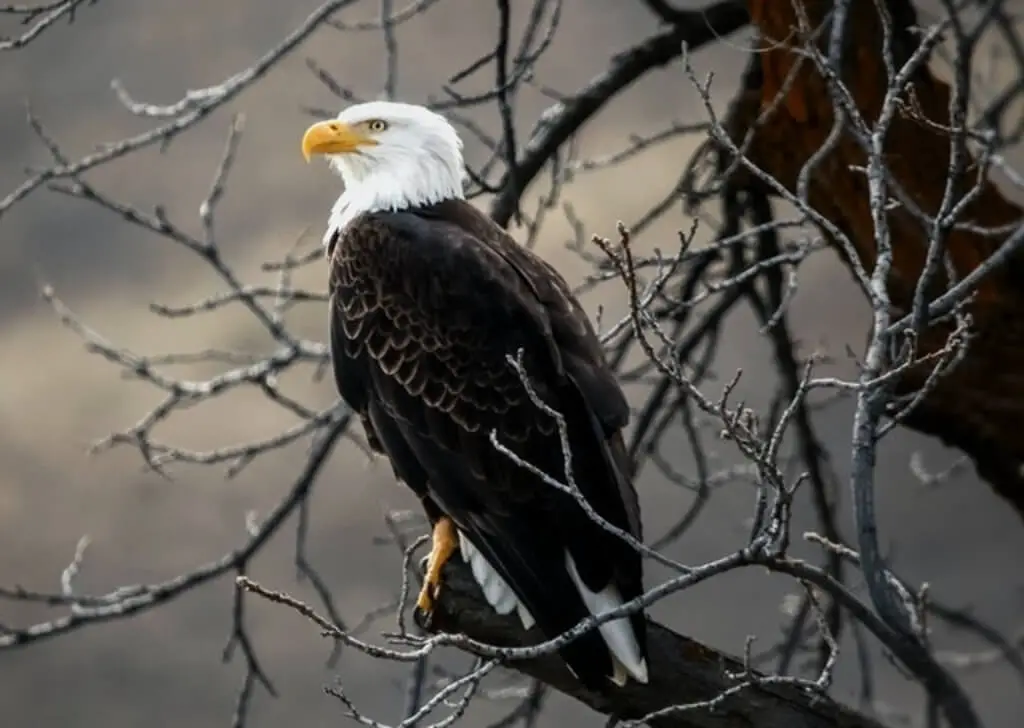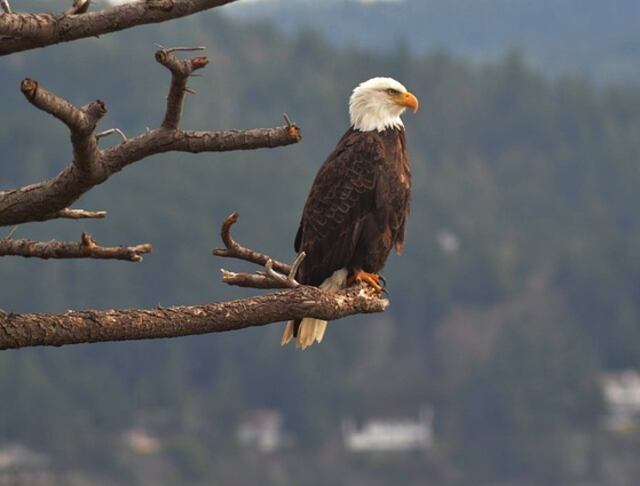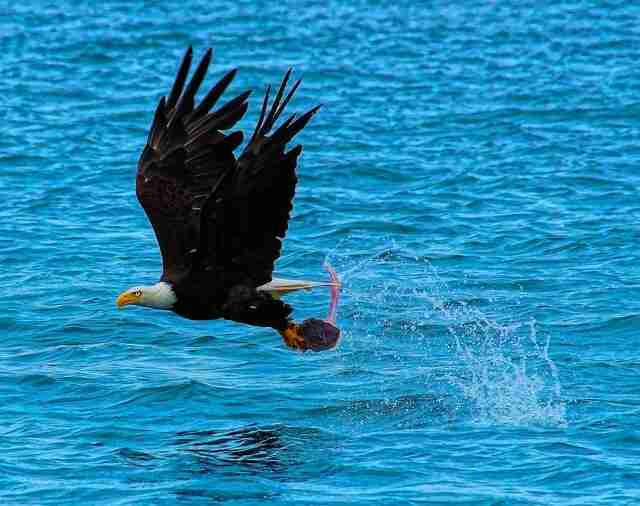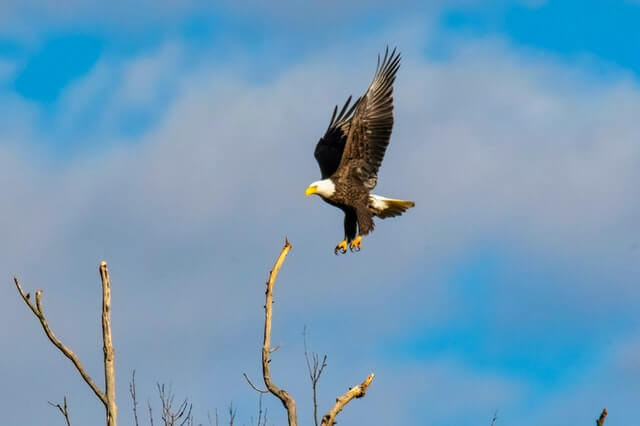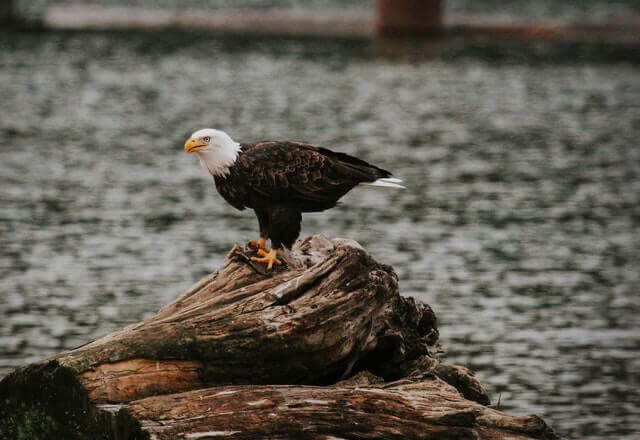Bald eagles are some of the most awe-inspiring creatures in North America, but do you really know what makes them so fascinating? From their soaring flight to their hunting prowess, these birds are full of surprises. Let’s dive into 55 bald eagle facts that’ll change the way you see these majestic raptors. You won’t believe some of the things we’ve uncovered!
Table of Contents
- 1 Bald Eagle Overview
- 2 Bald Eagle Facts
- 2.1 Bald Eagles Are Only Found in North America
- 2.2 Bald Eagles Belong to the “Haliaeetus” Bird Family
- 2.3 The Bald Eagle’s Scientific Name is “Haliaeetus leucocephalus”
- 2.4 Bald Eagles Are Surprisingly Fast
- 2.5 Bald Eagles Begin Their Nesting Season in December
- 2.6 They Live Mostly Near Large Bodies of Water
- 2.7 They Are One of North America’s Largest Birds of Prey
- 2.8 A Bald Eagle’s Lifespan is Over 50 Years
- 2.9 Bald Eagles’ Typical Altitude
- 2.10 A Bald Eagle’s Talons Can Grow Up to 3 Inches Long
- 2.11 Bald Eagles Aren’t Born With White Heads
- 2.12 Bald Eagles Are Monogamous and Mate for Life
- 2.13 Female Bald Eagles Are Larger Than Males
- 2.14 Baby Eagles Are Called Eaglets or Fledglings
- 2.15 The Bald Eagle, America’s National Bird
- 2.16 A Group of Bald Eagles is Called a “Convocation”
- 2.17 An Eagle’s Vision Is 4 to 8 Times Better Than Humans
- 2.18 The Bald Eagle is a Symbol of American Patriotism
- 2.19 Bald Eagles Can Fly at Altitudes of Up to 10,000 Feet
- 2.20 Bald Eagles Have an Impressive Hunting Range
- 2.21 Bald Eagles Are Opportunistic Scavengers
- 2.22 They Can Carry Prey Up to Half Their Body Weight
- 2.23 Bald Eagles Can See Prey from 3 Miles Away
- 2.24 The Bald Eagle’s Nests Are the Largest of Any North American Bird
- 2.25 Bald Eagles Have a Unique Call
- 2.26 Bald Eagles Are Adaptable to Various Habitats
- 2.27 Bald Eagles Can Live Without Nesting for a Year
- 3 Author
Bald Eagle Overview
- Length: 27.6-38.2 in (70-97 cm)
- Weight: 105.8-222.2 oz (6.6 -14 lbs.)
- Wingspan: 70-90.5 in (177.8-230 cm)
- Kingdom: Animalia
- Phylum: Chordata
- Class: Aves
- Order: Accipitriformes
- Family: Accipitridae
- Genus: Haliaeetus
- Species: H. leucocephalus
- Binomial Name: Haliaeetus leucocephalus (Carl Linnaeus 1766)
- Scientific Name: Haliaeetus leucocephalus
- Range: The Bald Eagle, the national bird of the United States, inhabits a vast range across North America, encompassing much of Canada, the entire continental US, and northern Mexico, as well as some areas in Central America and several Caribbean islands.
- Migration: Bald Eagles tend to migrate south to warmer climates when winter approaches, with Florida being a popular destination. They also migrate north for breeding season, typically from late February through mid-June or early July, which helps them take advantage of abundant food sources. Coastal regions such as the Pacific Northwest and Alaska are homebase points for the birds, since they offer up plenty of fish. During their migrations in other parts of the United States, they prefer to stay close to shorelines and inland rivers where prey is abundant. The path of their migration route thus tends to follow bodies of water like lakes, rivers, bays and more so that they may feed on fish, amphibians and other aquatic creatures throughout their journey.
- Habitat: The Bald Eagle’s main habitats are typically near large bodies of water. They can be found near coasts, rivers, lakes, marshes, or even wetlands. In the United States, they can also be found on inland prairies as well as high mountains. The reason for this is because of their need for open space and plenty of food sources like fish and small mammals.
- Diet: Its diet mainly consists of fish, but it will also hunt small mammals and scavenge carrion. It’s been found that the eagle will migrate between areas with more plentiful food sources during certain times of year. The eagle has also adapted to taking advantage of human-provided resources such as dumpsters, garbage cans, and roadkill when available. This flexibility in its diet allows the bald eagle to thrive throughout much of its range. Furthermore, this species is able to adjust their eating habits based on the seasons and availability of food sources. This adaptation makes them particularly well suited for survival in diverse environments.
- Global extent of occurrence: 28,400,000 km2 (10,965,301.3 sq mi.)
- Global Population: est. 316,700 mature individuals. – 71,400 nesting pairs.
- European Population: 0
- Conservation Status: Listed as Least Concern (Population Increasing).
- Lifespan: In the Wild: 15–25 years of age. – In Captivity: Up to 50 years of age.
- Breeding Period: Between November and late May. Breeding season varies by region.
- Incubation Duration: 34–36 days.
- Nestling Duration: 56–98 days.
- Chicks Fledge: 10–12 weeks of age.
- Clutch Size: 1–3 eggs.
- Number of Broods: 1 brood per year.
- Egg Color: Dull white with no markings.
- Nesting Habits: Bald Eagles are majestic birds of prey whose nesting preferences vary depending on their habitat. In regions with trees, they build high-up nests near to the trunk and away from the crown, unlike Ospreys. Meanwhile, in more southern areas, Bald Eagles can often be seen nesting in deciduous trees, mangroves and even cacti. It is unknown who chooses the nest site; however, it seems that taller coniferous trees protruding above the forest canopy offer them easy access to flight and good visibility.
Bald Eagle Facts
Bald Eagles Are Only Found in North America
Bald eagles are native to North America, with an estimated population of over 317,000 in the United States alone. Once endangered due to habitat destruction and pesticide use, their population has made a remarkable comeback thanks to conservation efforts.
Bald Eagles Belong to the “Haliaeetus” Bird Family
Bald eagles belong to the Haliaeetus genus, which is commonly known as sea eagles. This genus includes other species like the White-tailed eagle (Haliaeetus albicilla) and the African fish eagle (Haliaeetus vocifer). Members of this group are known for their large size and specialized hunting skills, often targeting fish and other aquatic prey.
The Bald Eagle’s Scientific Name is “Haliaeetus leucocephalus”
The scientific name for the bald eagle, “Haliaeetus leucocephalus,” translates to “sea eagle with a white head,” reflecting their distinctive appearance and habitat.
Bald Eagles Are Surprisingly Fast
Bald eagles are not only beautiful but also incredibly fast. They can cruise at speeds of 40 mph (64 km/h) and dive at speeds of 100 mph (160 km/h), making them one of North America’s fastest birds.
Bald Eagles Begin Their Nesting Season in December
In the northern United States, bald eagles typically begin their nesting season between January and March, with egg-laying occurring between end of February and April. Their reliance on clean water and healthy ecosystems makes them important indicators of environmental health.
They Live Mostly Near Large Bodies of Water
Bald eagles prefer habitats near large bodies of water like lakes, rivers, and coastlines, where fish are abundant. However, they are also known to hunt small mammals and scavenge carrion when fish are less available.
They Are One of North America’s Largest Birds of Prey
Bald eagles are indeed one of North America’s largest birds of prey. They can weigh up to 14 pounds (6.3 kg) and have a wingspan of up to 7.5 feet (2.3 meters). Their impressive size and powerful talons make them skilled hunters.
A Bald Eagle’s Lifespan is Over 50 Years
In the wild, bald eagles typically live around 20-30 years. However, in captivity, where they receive proper care and nutrition, some have been known to live over 50 years.
Bald Eagles’ Typical Altitude
Bald eagles typically hunt from altitudes of 200 to 1,000 feet, often from perches or while soaring in search of prey. These majestic birds rely on their keen eyesight to spot food from great distances while gliding through the air. Although they usually hunt at these lower altitudes, bald eagles are capable of soaring much higher—up to 10,000 feet (3,048 meters)—especially during migration, when they take advantage of thermal updrafts to cover long distances.
A Bald Eagle’s Talons Can Grow Up to 3 Inches Long
A bald eagle’s talons can grow up to 2 to 3 inches (5-7.5 cm) long and are powerful enough to exert 400 pounds of pressure per square inch, allowing them to catch and carry heavy prey.
Bald Eagles Aren’t Born With White Heads
Bald eagles aren’t born with their signature white heads. Instead, their heads gradually turn white as they mature, typically between 4 and 5 years of age. During this period, new feathers grow with pale tips, and over time, these feathers develop into the distinctive white head that is instantly recognizable.
Bald Eagles Are Monogamous and Mate for Life
Bald eagles are monogamous and generally mate for life. They share a single nest, fiercely defend it from intruders, and work together to care for their eggs and young, building strong and lasting family bonds. This lifelong partnership strengthens their success as hunters and parents.
Female Bald Eagles Are Larger Than Males
Female bald eagles are typically larger than males, often weighing more. This size difference helps females to better lay and incubate eggs and store essential fat reserves to survive harsh weather or times when food is scarce, giving them a greater advantage in nurturing their young.
Baby Eagles Are Called Eaglets or Fledglings
Baby bald eagles, called eaglets or fledglings, remain in the nest for around 8 weeks until their feathers fully develop and they are strong enough to fly. Their first flight, known as “fledge,” is a major milestone in their development and marks their transition into young adulthood.
The Bald Eagle, America’s National Bird
The bald eagle has represented the United States since June 20, 1782, when it was officially adopted as the national emblem by the Continental Congress. It symbolizes freedom, strength, and independence, appearing on various U.S. coins, government seals, and official emblems, reflecting the nation’s core values.
A Group of Bald Eagles is Called a “Convocation”
A group of bald eagles is called a “convocation”. This term was first popularized by naturalist John James Audubon in 1827. While it’s used to describe any gathering of bald eagles, it typically refers to groups that can range from a few individuals to several hundred, often seen during migration or when food is plentiful.
An Eagle’s Vision Is 4 to 8 Times Better Than Humans
Bald eagles have some of the best eyesight in the animal kingdom, with vision that is 4 to 8 times better than humans. Their keen eyesight allows them to detect small movements from great distances, which is essential for spotting prey. They can also see ultraviolet light, which helps them locate animals that might otherwise be hard to spot.
The Bald Eagle is a Symbol of American Patriotism
The bald eagle has long been a symbol of American patriotism. Chosen as the national emblem in 1782, the bald eagle represents freedom and strength. It is prominently featured on the Great Seal of the United States, various state flags, coins, and is also used in countless government emblems, reinforcing the nation’s ideals.
Bald Eagles Can Fly at Altitudes of Up to 10,000 Feet
Bald eagles are known to soar to incredible altitudes, often flying as high as 10,000 feet in search of prey. This altitude allows them to spot potential food sources from a distance while riding thermal currents, which help conserve energy during long flights. Such remarkable flying ability enables them to cover large areas while hunting.
Bald Eagles Have an Impressive Hunting Range
Bald eagles can have a hunting range that spans from 1,700 to 10,000 acres, depending on food availability and nesting locations. Their territorial instincts and ability to cover vast distances make them skilled hunters, capable of locating fish, birds, or even carrion in expansive areas.
Bald Eagles Are Opportunistic Scavengers
While bald eagles are primarily fish-eaters, they are also opportunistic scavengers. They will readily eat carrion, steal food from other predators, or even share their catch with other eagles. This adaptability allows them to survive in varied environments where food may not always be abundant.
They Can Carry Prey Up to Half Their Body Weight
Bald eagles have incredibly strong talons and are capable of carrying prey weighing up to half of their body weight. Whether it’s a fish, small mammal, or another bird, they use their powerful grip to transport their catch back to their nests or feeding grounds. This remarkable strength allows them to secure large meals and ensure their survival.
Bald Eagles Can See Prey from 3 Miles Away
The bald eagle’s vision is one of its most impressive traits. They can spot prey from up to 3 miles away while soaring high in the sky. Their acute eyesight allows them to spot even the slightest movement from great distances, making them highly efficient hunters.
The Bald Eagle’s Nests Are the Largest of Any North American Bird
Bald eagles build the largest nests of any bird in North America, with some nests reaching 10 feet in diameter and weighing several tons. These massive structures are typically built in tall trees near water, offering a perfect vantage point for hunting and safety. Nests are often used for several years and are reinforced each breeding season.
Bald Eagles Have a Unique Call
Bald eagles are known for their distinctive call, a high-pitched sound that is often confused with the call of a red-tailed hawk. This vocalization plays an important role in territorial defense and during the mating season, where eagles use calls to communicate with their mates and warn other eagles to stay away.
Bald Eagles Are Adaptable to Various Habitats
While often associated with coastal areas, bald eagles are incredibly adaptable and can thrive in a wide variety of habitats. They can be found near lakes, rivers, marshes, and even in urban environments close to human populations, as long as there’s access to food and suitable nesting locations.
Bald Eagles Can Live Without Nesting for a Year
In some cases, bald eagles will take a year off from nesting, especially if environmental conditions aren’t suitable for breeding. They are known to migrate long distances during winter, and if conditions aren’t favorable for raising young, they will focus on survival and return to breeding when conditions improve.
Related Post: 5 Birds That Look Like Bald Eagles (Explained)

